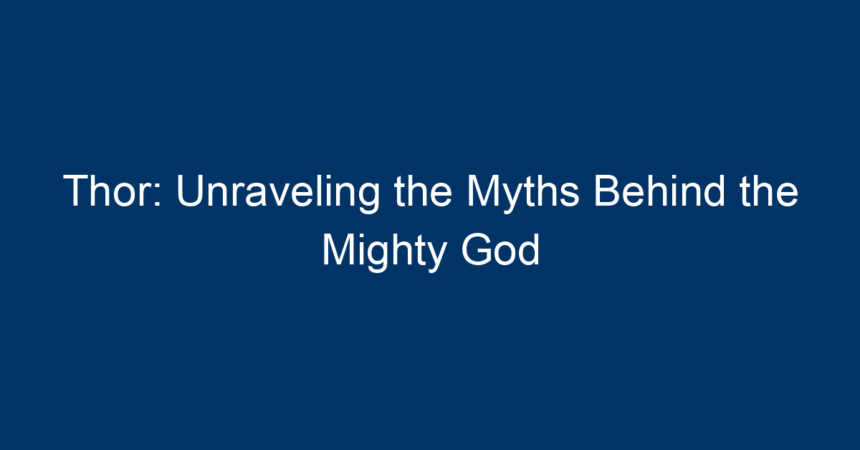Thor, the Norse god of thunder, has captured the imagination of people around the world for centuries. From ancient sagas to modern blockbuster films, the figure of Thor embodies strength, bravery, and the elemental forces of nature. This article delves deep into the myths surrounding Thor, exploring his origins, the significance of his hammer, Mjölnir, and the lessons we can learn from his legendary tales.
Who is Thor? The Origins of the Thunder God
Thor is one of the most revered deities in Norse mythology, known as the god of thunder, lightning, storms, oak trees, and strength. He is often depicted as a powerful figure with a red beard, wielding his iconic hammer, Mjölnir.
The Progeny of Odin
Thor is not merely a standalone figure; he is the son of Odin, the chief of the Aesir gods, and Jord, the personification of the Earth. In this context, Thor symbolizes the warrior spirit and the vitality of the natural world. His dual heritage reflects the blend of sky and earth, thunder and land, making him an integral part of the Norse pantheon.
Cultural Significance
Thor’s significance extends beyond myth. He represents strength and protection, often serving as a defender of both gods and humans against the forces of chaos, represented by the giants (Jotunn). In many sagas, his battles against these giants highlight the eternal struggle between order and chaos, civilization and nature.
Mjölnir: The Hammer of Thor
One cannot discuss Thor without mentioning Mjölnir, his magical hammer. More than just a weapon, Mjölnir is a symbol of protection, blessing, and initiation.
The Creation of Mjölnir
According to myth, Mjölnir was crafted by the dwarves Sindri and Brokkr. The hammer is said to have the power to level mountains, summon lightning, and return to Thor’s hand after being thrown. Its creation story is rooted in the trials that the dwarves purposefully concocted, showcasing themes of rivalry and ingenuity.
Symbol of Protection
In ancient Norse culture, Mjölnir was used in various rituals, including weddings and childbirth, to invoke blessings and protection. The hammer not only signifies Thor’s might but also embodies the protective spirit of the warrior. For many, wearing a Mjölnir amulet offered a sense of safety, reinforcing Thor’s role as a guardian.
Thor’s Companions and Rivals
Thor’s adventures are rich with a cast of characters that add depth to his mythos. From the cunning Loki to other gods and giants, these figures play crucial roles in shaping Thor’s narrative.
Loki: The Trickster God
Loki, Thor’s companion and sometimes adversary, brings complexity to Thor’s stories. Their relationship is marked by a mixture of camaraderie and betrayal. Loki’s tricks often land Thor in difficult situations, but it is their partnership that ultimately leads to thrilling escapades.
The Giants of Jotunheim
Thor’s battles against the giants, particularly the character of Jormungandr (the Midgard Serpent), symbolize humanity’s eternal struggle against chaos. These confrontations are not just battles of physical strength but also represent the clash of civilization against the untamed forces of nature.
Thor in Modern Culture
Thor’s persona has transcended ancient mythology, finding new life in literature, film, and comic books, particularly through Marvel Comics and the Marvel Cinematic Universe (MCU).
The Marvel Adaptation
In the MCU, Thor is portrayed by Chris Hemsworth as a charismatic and humorous character while retaining his warrior attributes. This modern interpretation has introduced millions to the myth of Thor, blending ancient narratives with contemporary storytelling.
Cultural Impact
The reinterpretation of Thor has made him a universal symbol of heroism. Merchandise, films, and comics continue to keep Thor relevant, merging ancient mythology with the values of today’s society.
Lessons from Thor’s Myths
The tales of Thor and his adventures hold significant lessons that resonate even today.
Strength and Compassion
Thor’s character is that of a robust warrior, yet he often displays compassion and loyalty. His relationships with his friends and family exemplify the importance of camaraderie and the value of standing up for others.
The Triumph of Good Over Evil
Thor’s perpetual battle against the giants symbolizes the triumph of good over chaos. Readers and viewers can take inspiration from his unwavering resolve to defend what is right, even in the face of overwhelming odds.
Conclusion: Embracing the Myths of Thor
Understanding Thor’s myths provides valuable insights into not only Norse culture but also universal human experiences. His stories remind us of the strengths we possess and the virtues we should cultivate. Whether through the lens of ancient mythology or modern adaptation, Thor stands as an enduring figure of heroism and strength.
Actionable Insights
As we explore the mighty Thor, consider how his attributes resonate in our lives:
- Embrace Strength: When faced with challenges, channel Thor’s unwavering strength and determination.
- Value Relationships: Cultivate connections with friends and family; like Thor, recognize the power of loyalty.
- Protect What Matters: Stand up for causes you believe in, embodying Thor’s role as a guardian against chaos.
Through understanding Thor, we not only honor the stories of the past but also find inspiration for our own journeys today. By recognizing the power of these myths, we can forge our paths with courage and conviction, much like the mighty god of thunder himself.




